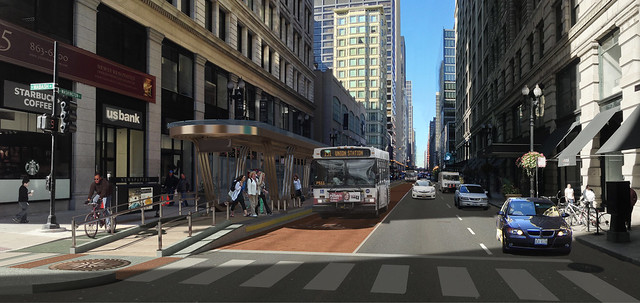So far, there’s been far less noise surrounding the city’s Central Loop Bus Rapid Transit project than the Ashland BRT plan. The $32 million downtown project, bankrolled by a Federal Transit Administration grant and local tax increment financing, will include dedicated lanes on Washington, Madison, Clinton, and Canal, serving six bus routes and 1,000 buses per weekday. Features will include a new multi-modal transit center next to Union Station, larger bus shelters, level boarding, protected bike lanes on Washington and Canal, and possibly pre-paid boarding and traffic signal prioritization.
However, there has been some grumbling from Loop business owners who are concerned that the BRT stops will obscure their storefronts, even though the shelters, heavily inspired by the winner of a design contest, will be mostly made of clear glass. Merchants are also concerned that if the bus lanes are camera enforced, delivery drivers will be ticketed for parking in them.
At the same time, many downtown businesses are seeing the big picture of how the Loop BRT will boost the economy by making it easier to access downtown job centers and attractions, as well as generating foot traffic for retail. I recently spoke to Michael Deering, spokesman for Blue Cross and Blue Shield of Illinois, headquartered at 300 East Randolph, about why his corporation is supporting the plan.
John Greenfield: How does Blue Cross think the Loop BRT will benefit the company?
Michael Deering: We feel that one of the main reasons Chicago is considered a world-class city is because of our robust transportation infrastructure. BRT is really part of furthering that vision of good infrastructure. By making it faster and easier to get across the Loop, it will increase company and employee productivity, and better enable Chicago-based companies to recruit workers.
BRT is clearly a continuation of our current transit system’s focus on moving people efficiently across the city. It’s taking advantage of the extensive bus network we already have and maximizing its efficiency.
JG: I’ve heard there’s been some resistance to the plan from some of the downtown merchants. [I outline the complaints.] What do you make of that?
MD: I can understand their concerns. But the potential benefits of the BRT system merit sitting down at the table and trying to address these concerns in a reasonable manner and find some resolution that would satisfy everyone’s needs. I don’t think everyone who’s impacted by the proposal really has a full picture of how the system will work. There’s an opportunity to address their concerns in a productive way.
JG: Any other thoughts?
MD: By improving the downtown transportation system, BRT is going to interconnect the transit stations and make it easier to get from the Metra stations in the West Loop to the east side of downtown. That’s going to allow more people from across the city and across the region to view downtown Chicago as a viable employment opportunity.






